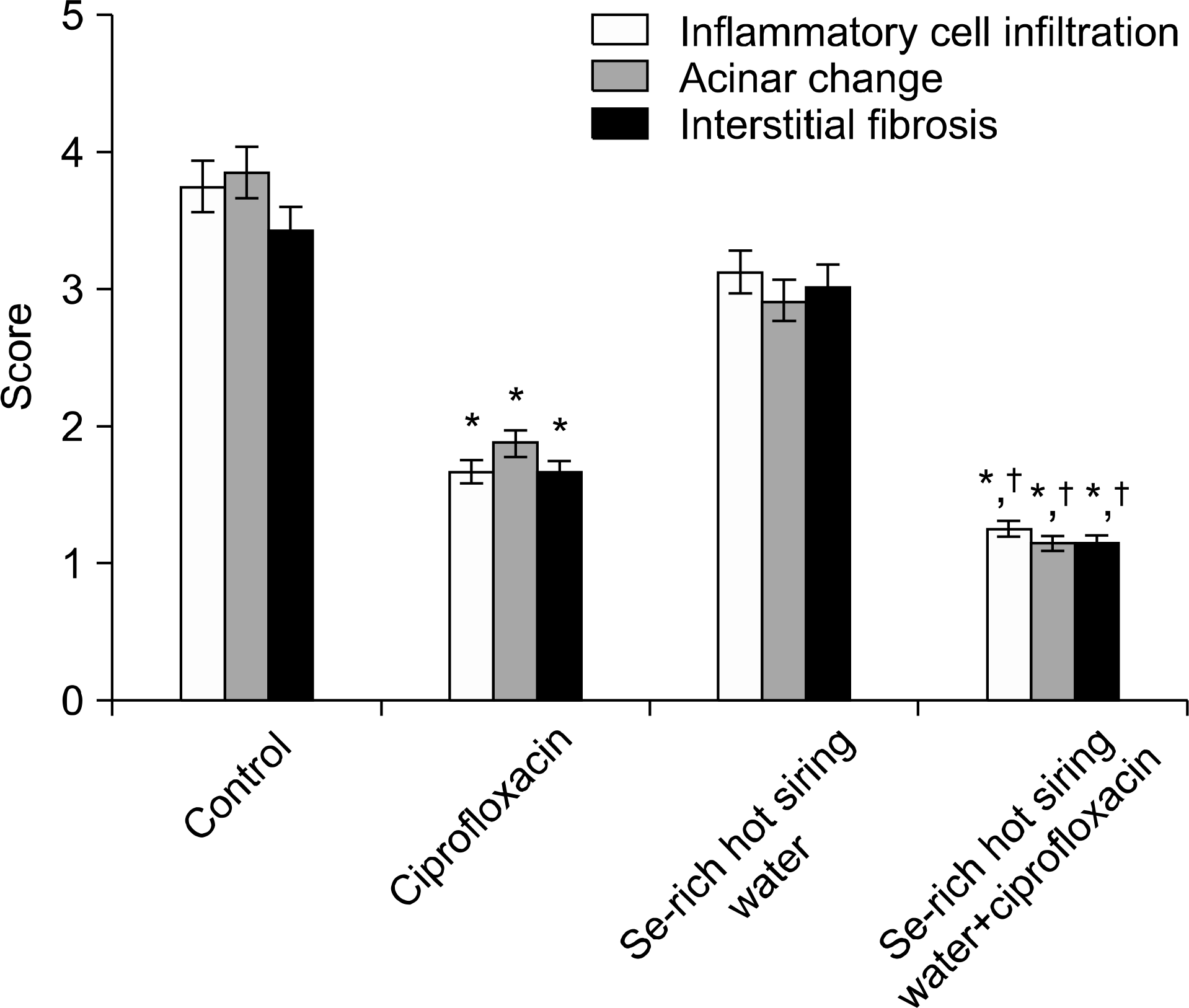Abstract
Purpose
The conventional primary therapy for chronic bacterial prostatitis (CBP) is the use of antibiotics. However, the therapy has a low cure rate and longterm use of antibiotics can lead to adverse effects including bacterial resistance. For these reasons, a new therapy for CBP is strongly needed.
Conclusions
These results suggest that spring water may be an effective material in the treatment of CBP. Notably, the combination treatment of selenium-rich hot spring water and ciprofloxacin has synergistic effects. Therefore, we can suggest that the combination of selenium-rich hot spring water and ciprofloxacin may be effective in the treatment of CBP, and with a higher success rate than ciprofloxacin alone.
Materials and Methods
To evaluate the anti-inflammatory and antimicrobial effects of selenium-rich hot spring water on CBP, rats were divided into four groups and treatment was administered for four weeks as follows: (1) control (n=8), (2) ciprofloxacin (n=8), (3) selenium-rich hot spring water (n=8), and (4) selenium-rich hot spring water with ciprofloxacin (n=8). Drip infusion of bacterial suspension (E. coli Z17 O2:K1;H−) into Spargue-Dowley rats was then conducted to induce CBP. Four weeks later, the results of prostate tissue and urine culture and histological analysis on the prostate were analyzed in each group.
Results
The use of ciprofloxacin, and selenium-rich hot spring water with ciprofloxacin showed statistically significant decreases in bacterial growth and improvements in prostatic inflammation compared with the control group (p<0.05). The selenium-rich hot spring water with ciprofloxacin group showed a statistically significantly lower rate of bacterial growth and and greater improvements in prostatic inflammation than the ciprofloxacin group (p<0.05).
Go to : 
REFERENCES
2). Rotruck JT, Pope AL, Ganther HE, Swanson AB, Hafeman DG, Hoekstra WG. Selenium: biochemical role as a component of glutathione peroxidase. Science. 1973; 179:588–90.

3). Maehira F, Luyo GA, Miyagi I, Oshiro M, Yamane N, Kuba M, et al. Alterations of serum selenium concentrations in the acute phase of pathological conditions. Clin Chim Acta. 2002; 316:137–46.

4). Galley HF, Davies MJ, Webster NR. Xanthine oxidase activity and free radical generation in patients with sepsis syndrome. Crit Care Med. 1996; 24:1649–53.

5). Sohn DW, Han CH, Jung YS, Kim SI, Kim SW, Cho YH. Anti-inflammatory and antimicrobial effects of garlic and synergistic effect between garlic and ciprofloxacin in a chronic bacterial prostatitis rat model. Int J Antimicrob Agents. 2009; 34:215–9.

6). Han CH, Yang CH, Sohn DW, Kim SW, Kang SH, Cho YH. Synergistic effect between lycopene and ciprofloxacin on a chronic bacterial prostatitis rat model. Int J Antimicrob Agents. 2008; 31(Suppl 1):S102-7.

7). Seo SI, Lee SJ, Kim JC, Choi YJ, SW SW, Hwang TK, et al. Effects of androgen deprivation on chronic bacterial prostatitis in a rat model. Int J Urol. 2003; 10:485–91.

8). Lee YS, Han CH, Kang SH, Lee SJ, Kim SW, Shin OR, et al. Synergistic effect between catechin and ciprofloxacin on chronic bacterial prostatitis rat model. Int J Urol. 2005; 12:383–9.

9). Jantos C, Altmannsberger M, Weidner W, Schiefer HG. Acute and chronic bacterial prostatitis due to E. coli. Description of an animal model. Urol Res. 1990; 18:207–11.
10). Moon TD. Questionnaire survey of urologists and primary care physicians' diagnostic and treatment practices for prostatitis. Urology. 1997; 50:543–7.

11). Terai A, Yamamoto S, Mitsumori K, Okada Y, Kurazono H, Takeda Y, et al. Escherichia coli virulence factors and serotypes in acute bacterial prostatitis. Int J Urol. 1997; 4:289–94.

12). Neal DE Jr, Moon TD. Use of terazosin in prostatodynia and validation of a symptom score questionnaire. Urology. 1994; 43:460–5.

13). McGuire EJ, Lytton B. Bacterial prostatitis: treatment with trimethoprim-sulfamethoxazole. Urology. 1976; 7:499–500.

14). Pei Z, Li H, Guo Y, Jin Y, Lin D. Sodium selenite inhibits the expression of VEGF, TGFbeta(1) and IL-6 induced by LPS in human PC3 cells via TLR4-NF-(K)B signaling blockage. Int Immunopharmacol. 2010; 10:50–6.
15). Zamamiri-Davis F, Lu Y, Thompson JT, Prabhu KS, Reddy PV, Sordillo LM, et al. Nuclear factor-kappaB mediates over-expression of cyclooxygenase-2 during activation of RAW 264.7 macrophages in selenium deficiency. Free Radic Biol Med. 2002; 32:890–7.
Go to : 
 | Fig. 1.Severity scores of chronic inflammatory cell infiltrations, acinar changes and interstitial fibrosis in each group. The values, expressed as means±SD, are compared with that of the control group. ∗p<0.05, compared with the control group, †p<0.05, compared with the ciprofloxacin group, SD: standard deviation. |
 | Fig. 2.Prostate section of a chronic bacterial prostatitis rat, obtained 2 weeks after each treatment (H&E, Bar=100μm). (A) The acinar structures are severely atrophied and obliterated. Marked chronic inflammatory cell infiltration and interstitial fibrosis are seen (Control group). (B) The acinar structures are mildly shrunken, with mild lymphocytic infiltration and fibrosis in the interstitial space (Ciprofloxacin group). (C) The acinar structures are moderately atrophied and obliterated. Moderate chronic inflammatory cell infiltration and interstitial fibrosis are seen (Se-rich hot spring water group). (D) The acinar structures have a nearly normal appearance, with mild lymphocytic infiltration and focal fibrosis in the interstitial space (Se-rich hot spring water/Ciprofloxacin group). |
Table 1.
Mineral components of hot-spring water
Table 2.
Microbiological data of prostate tissue and urine culture in rats
| Group (no. of rats) | Mean (±SD) log10 | Mean (±SD) log10 |
|---|---|---|
| CFU/g of prostate tissue | CFU/g of urine | |
| Control | 6.228±0.366 | 3.394±0.283 |
| Ciprofloxacin | 3.391±0.275∗ | 1.700±0.269∗ |
| Se-rich hot spring water | 5.047±0.518 | 2.719±0.235 |
| Se-rich hot spring water + ciprofloxacin | 1.962±0.344† | 1.069±0.262† |




 PDF
PDF ePub
ePub Citation
Citation Print
Print


 XML Download
XML Download